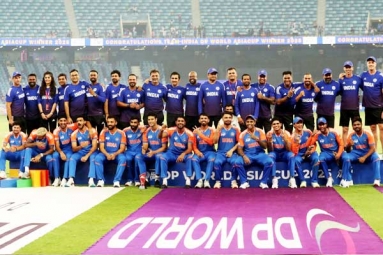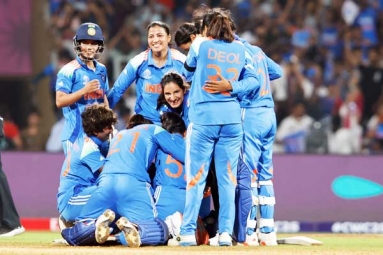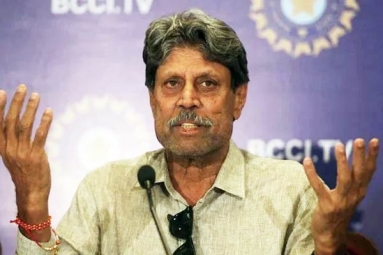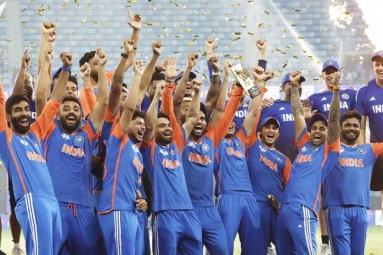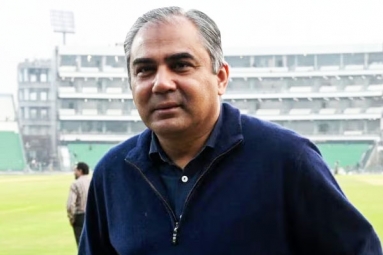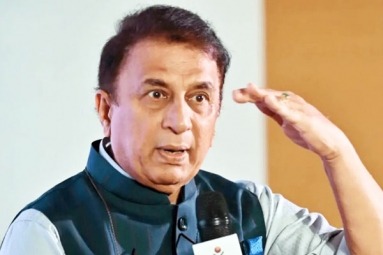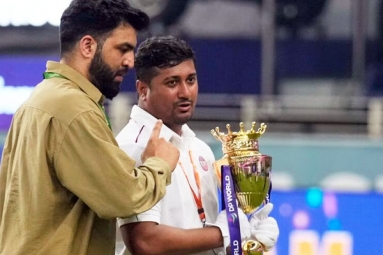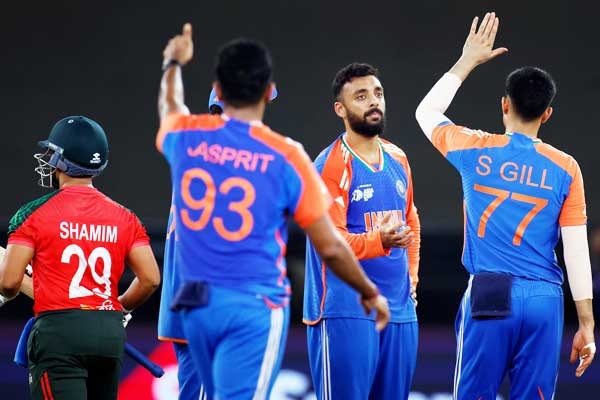
(Image source from: x.com/BCCI)
India has reached the finals of the Asia Cup 2025, where they will face the winner of Thursday's match between Bangladesh and Pakistan in the Super Fours. Sri Lanka is no longer in the running, making their game against India on Friday irrelevant. India secured their final spot by defeating Bangladesh by 41 runs, a win that was both easy and a bit unsettling for them. Bangladesh never really seemed likely to win during their pursuit of 169 runs, as India's bowling showcased their skills and variety, highlighting the weaknesses of Bangladesh as a T20 team. However, Bangladesh may feel they could have fared better after their bowlers successfully restricted India's scoring when Abhishek Sharma appeared ready to lead them to a score above 200. Abhishek continued his impressive performance in the tournament, following a strong 39-ball 74 against Pakistan with a 37-ball 75, but India's batting faltered when he wasn't there.
India's innings mirrored Pakistan's performance against their bowlers on Sunday: a solid start that slowed down dramatically once the ball lost its freshness. India accumulated 95 runs during overs 3-11, when Abhishek was in great form, but only managed 73 runs in the 12 overs before and after that period. Ultimately, Abhishek's performance made the difference between the two teams. Bangladesh lacked a player with the same relentless ability to hit boundaries, although Saif Hassan showed potential by scoring five sixes in his 51-ball 69. Bangladesh could have gotten Abhishek out for just 7 runs off 8 balls in the third over if the wicketkeeper had held onto an edge from Tanzim Hasan Sakib, who was one of four new players in the lineup and bowled exceptionally well with the new ball, swinging it effectively while also putting it right on target.
The wicketkeeper who missed that opportunity and also served as Bangladesh's captain that night was Jaker Ali, filling in for Litton Das, who was sidelined by a side injury. This moment marked the end of the match's early phase, which Bangladesh controlled without being able to separate Abhishek from Shubman Gill. Tanzim had already beaten Gill's bat twice in the first over, and left-arm spinner Nasum Ahmed skillfully used his swinging arm ball to keep the ball out of Abhishek's hitting range in the second over. By the end of the third over, India was still scoring less than a run a ball. Gill initiated a counterattack by stepping out to the first two deliveries of the fourth over, striking Nasum for a four and a six. This sparked an onslaught of boundary-hitting that Bangladesh appeared unable to stop. Abhishek seemed unbeatable once he adjusted to the conditions, hitting Mustafizur Rahman for two sixes in the fifth over, and delivering four fours off Mohammad Saifuddin in the sixth, maintaining this level of play beyond the powerplay.
In total, Abhishek hit five sixes, which placed him at joint No. 7 on India's list for most sixes in T20I cricket history. He has now hit 58 sixes in just 21 innings, while Suresh Raina, who he tied with, scored 58 in 66 innings.
At the start of the 12th over, India was at 112 for 2, and it seemed like Bangladesh could not stop Abhishek. However, they managed to do so with a run-out that was made possible by Rishad Hossain's excellent play at backward point. He dove to his left to stop a shot from Suryakumar Yadav and quickly got up to throw in one smooth motion, leaving Abhishek with very little chance to get back to safety at the non-striker's end.
This moment shifted the game's momentum, revealing a weakness in India's middle order that has troubled many teams in similar conditions in the UAE – the struggle to start innings with an older ball. Bangladesh's bowlers also did their job, with Mustafizur, Tanzim, and Saifuddin effectively using their slower balls, while Nasum cleverly varied his speed, leading India to score only 56 runs in the last nine overs. Hardik Pandya, who got out on the final ball of the innings for 38 from 29 deliveries, was the main run-scorer.
India’s decline looked worse because they changed their batting order, which didn’t work out that day. They moved Shivam Dube up to No. 3 and brought in Hardik, Tilak Varma, and Axar Patel ahead of Sanju Samson, who didn’t get a chance to bat at all. Bangladesh appeared to have a real opportunity at the halfway point, but the rate they needed to score kept getting further out of reach. Jasprit Bumrah, again bowling three overs in the powerplay, got a wicket in his first over and looked nearly impossible to hit with the new ball, swinging it remarkably and at one point beating Parvez Hossain Emon’s bat six times in eight deliveries.
Then, just when Emon seemed to recover from his early struggles with a six off Bumrah and two swept fours off Varun Chakravarthy, he got out trying to play a slog-sweep in Kuldeep Yadav's first over, which was the seventh of the innings. The game then became one of two ends. On one side, Saif displayed his hitting skills, especially against Axar, whom he hit for three sixes. On the other side, batters kept getting out, with Jaker being run out in the 13th over while trying to take a quick single to help Saif reach his fifty, which effectively ended Bangladesh's hopes.
All that was left was for Kuldeep to execute his usual trick of taking two wickets in two balls, for India's fielders to drop several catches, allowing Saif's innings to continue into the 18th over, for Bumrah to return and grab a second wicket, and finally for part-timer Tilak to finish the game with three balls to go.







